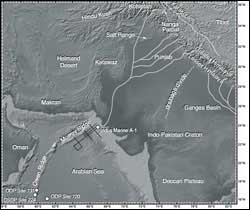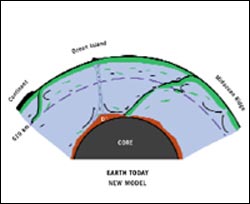
Scientists have long recognized that the collision of the earth’s great crustal plates generates mountain ranges and other features of the Earth’s surface. Yet the link between mountain uplift and river drainage patterns has been uncertain. Now scientists have used laboratory techniques and sediment cores from the ocean to help explain the how rivers have changed course over millions of years.
In a report published in the December 15 issue of Nature, scientists Peter Clift of t
DNA links genetic lineage of western hemisphere insects to African desert locust
Somewhere between three and five million years ago, a massive swarm of locusts took off from the west coast of Africa and made an unlikely voyage across the Atlantic Ocean to colonize the New World, says an international team of researchers.
Using genetic evidence from more than 20 species of locusts, scientists from the Universities of Toronto, Arizona, Maryland, Cornell University and
Science honors the top ten research advances of 2005
Evolution has been the foundation and guiding theory of biology since Darwin gave the theory its proper scientific debut in 1859. But Darwin probably never dreamed that researchers in 2005 would still be uncovering new details about the nuts and bolts of his theory — how does evolution actually work in the world of influenza genes and chimpanzee genes and stickleback fish armor? Studies that follow evolution in action claim top h

Earth’s future was determined at birth. Using refined techniques to study rocks, researchers at the Carnegie Institution’s Department of Terrestrial Magnetism (DTM) found that Earth’s mantle–the layer between the core and the crust–separated into chemically distinct layers faster and earlier than previously believed. The layering happened within 30 million years of the solar system’s formation, instead of occurring gradually over more than 4 billion years, as the standard model suggests. The ne
Geologic features at the Opportunity landing site on Mars were formed not by a lake that evaporated but by constant strikes from meteorites, say two Arizona State University geologists.
The site where the Mars Exploration Rover Opportunity landed has sediments and layered structures that are thought to be formed by the evaporation of an acidic salty sea. The prevailing thought is that when this Martian sea existed it may have supported life forms and thus would be a prime site
The second member of Europe’s new generation of weather satellites has successfully been lifted onto orbit, continuing an uninterrupted series of launch successes since 1977.
This ninth Meteosat satellite, developed on behalf of EUMETSAT under the aegis of the European Space Agency, will reinforce EUMETSAT’s capacity to monitor the Earth atmosphere above Europe, Africa, the Middle-East and the Atlantic Ocean.
MSG-2 (2nd flight model of Meteosat Second Generation) was o